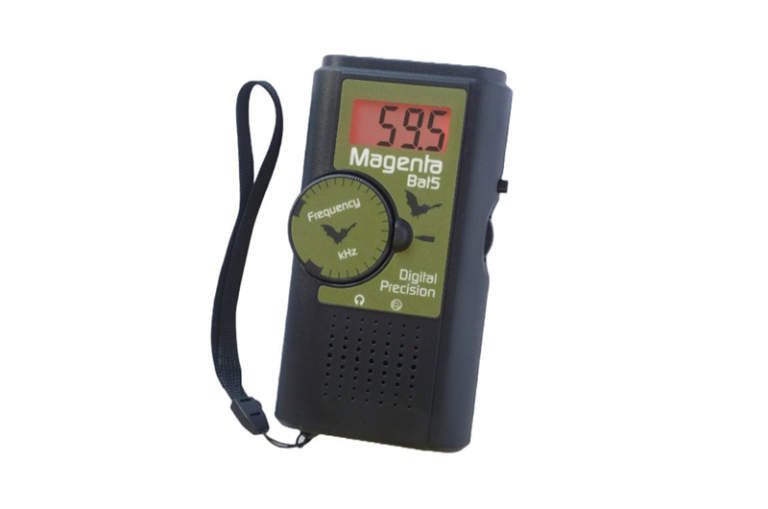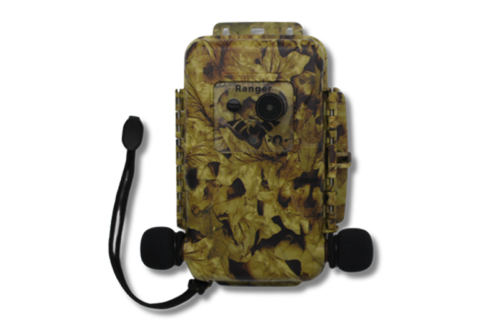- Hong Kong Bat Radar
- Bat Detector
Bat Detector (TBC)
Bat detectors are specialized devices used in bat research and conservation. Different models have varying technical specifications and functionalities, requiring careful selection to suit the specific needs of a project. Factors such as frequency range, signal to noise ratio, and recording capabilities must be considered to ensure the most appropriate detector is chosen, as the selected device can significantly impact data quality and accuracy. Thorough evaluation of project objectives and available detector capabilities is essential for obtaining reliable and meaningful results from bat-related studies and monitoring programs.
Five main systems

Heterodyne
Tuneable detector that converts bat calls to audible frequencies by mixing with a local oscillator with the desired frequency.

Frequency Division
Broadband detector that outputs detected sound in real-time, with frequencies divided by (eg. 10) for recording.

Zero Crossing
Broadband detector that records sounds as data points showing frequency changes over time.

Time Expansion
Broadband detector that captures a short sound sample and plays it back at a slower speed (x10 / x20) for recording.

Full Spectrum
Broadband detector that records sound in real-time at original frequencies using high sampling rates.
Important specification
Sampling rate
Sampling rate
The maximum recordable frequency is determined by the sampling rate where a sample rate of 256 kHz allows the recording of sounds up to 128 kHz (half the sample rate). It also determine the resolution of spectrogram and power spectrum.
Gain level
Gain level
Adjusting the gain allows the recorder to optimize the dynamic range and signal strength for the specific recording environment and bat species being monitored. This ensures the recordings have the best possible quality for subsequent analysis.
Bit depth
Bit depth
The bit depth of a bat recorder is crucial as it determines the dynamic range and signal-to-noise ratio captured. Higher bit depths, such as 16-bit or 24-bit, allow for higher resolution of amplitude, enabling better analysis and identification.
Signal-to-noise ratio
Signal-to-noise ratio
A high signal-to-noise ratio ensures bat calls are clearly distinguishable from background noise, enabling accurate species identification and detailed acoustic analysis.
Trigger
Trigger
The trigger setting determines when the recorder starts and stops capturing audio, ensuring only bat calls are recorded and reducing file sizes. Proper trigger settings minimize background noise and optimize storage space, enabling more effective survey.
Auto noise detection
Auto noise detection
Auto noise detection and trash feature automatically identify and filter out non-bat sounds, such as wind, rain and insect noise. It reduces the amount of manual post-processing required, saving time and effort.
Real-time spectrogram
Real-time spectrogram
Real-time spectrogram display allows users to instantly visualize the frequency and temporal characteristics of bat calls, enabling on-site identification, observation and adjustment of recording parameters.
Weatherproof
Weatherproof
It protects the device from environmental elements like rain, wind, and dust, ensuring uninterrupted operation and data collection. It also extends the recorder’s lifespan and reliability, enabling long-term, continuous monitoring of bat activity under diverse outdoor conditions.
Bat detector products


| Brand | Detector model | Release Year | Type | Microphones | Sample rate (kHz) | Frequency range (kHz) | Gain Adjustment (dB) | Filter option | File type | Schedule | Noise scrubber |
|---|---|---|---|---|---|---|---|---|---|---|---|
| Wildlife Acoustic | Song Meter SM2Bat | 2009 | Passive | SMX-US | 192 / 384 | 0 - 192 | 12 / 36 / 48 / 60 | HPF / LPF | 16-bit Wav / Wac | Yes | No |
| Song Meter SM2Bat+ | 2011 | Passive | SMX-US | 192 / 384 | 0 - 192 | 12 / 36 / 48 / 60 | HPF / LPF | 16-bit Wav / Wac / ZC | Yes | No | |
| Song Meter SM3Bat | 2014 | Passive | SMM-U1 | 192 / 256 / 384 | 8 - 192 | 12 | 16kHz HPF | 16-bit Wav / Wac | Yes | No | |
| Song Meter SM4Bat FS | 2016 | Passive |
SMM-U1 / SMM-U2 |
192 / 256 / 384 / 500 |
SMM-U1: 8 - 156 SMM-U2: 1 - 156 |
12 | 16kHz HPF | 16-bit Wav / Wac | Yes | Yes | |
| Song Meter SM4Bat ZC | 2016 | Passive | N/A | N/A | 16kHz HPF | ZC | Yes | Yes | |||
| Song Meter Mini Bat | 2020 | Passive | Built-in | 192 / 256 / 384 / 500 | 8 - 191 | 6 / 12 | N/A | 16-bit Wav / ZC | Yes | Yes | |
| Song Meter Mini Bat 2 | 2023 | Passive | Built-in | 256 / 384 / 500 | 8.25 - 191 | 6 / 12 | N/A | 16-bit Wav / ZC | Yes | Yes | |
| Echo Meter 3 | 2011 | Active | Built-in | 256 / 384 | 1 - 192 | 24 / 30 / 36 | N/A | 16-bit Wav / Wac / ZC | Yes | Yes | |
| Echo Meter 3+ | 2013 | Active | Built-in | 256 / 384 | 1 - 192 | 24 / 30 / 36 | N/A | 16-bit Wav / Wac / ZC | Yes | Yes | |
| Echo Meter Touch 1 | 2014 | USB Microphone | 256 | 8 - 128 | N/A | N/A | 12-bit Wav | No | Yes | ||
| Echo Meter Touch 2 | 2017 | USB Microphone | 256 | 0 - 128 | N/A | N/A | 16-bit Wav | No | Yes | ||
| Echo Meter Touch 2 Pro | 2017 | USB Microphone | 256 / 384 | 8 - 192 | -12 / +12 | N/A | 16-bit Wav | No | Yes | ||
| Pettersson Elektronik | D240X | 2003 | Active | Built-in | 307 | 10 - 120 | Low / High | N/A | 8-bit Wav | No | No |
| D1000X | 2007 | Active | Built-in | 32 / 44.1 / 48 / 96 / 100 / 192 / 200 / 250 / 300 / 384 / 400 / 500 / 750 / 768 | 5 - (0.4 x sample rate) | Adjustable | 20kHz HPF | 16-bit Wav | No | No | |
| D500X MkI | 2009 | Passive | Built-in | 44.1 / 300 / 500 | 5 - 190 | Adjustable | 20kHz HPF | 16-bit Wav | Yes | No | |
| D500X MkII | 2009 | Passive | External | 44.1 / 300 / 500 | 5 - 190 | Adjustable | 20kHz HPF | 16-bit Wav | Yes | No | |
| M500 | 2014 | USB Microphone | 500 | 10 - 210 | N/A | N/A | 16-bit Wav | No | No | ||
| M500-384 | 2016 | USB Microphone | 384 | 10 - 160 | N/A | N/A | 16-bit Wav | No | No | ||
| u256 | 2019 | USB Microphone | 256 | 1 - 128 | N/A | N/A | 16-bit Wav | No | No | ||
| u384 | 2019 | USB Microphone | 384 | 1 - 192 | N/A | N/A | 16-bit Wav | No | No | ||
| Titley Scientific | Anabat Express | 2009 | Passive |
US–O / US–D |
192 / 320 / 500 |
US-O: 10 - 150 US-D: 10 - 250 |
N/A | N/A | Wav / ZC | Yes | No |
| Anabat Swift | 2017 | Passive | 192 / 320 / 500 | N/A | N/A | Wav / ZC | Yes | No | |||
| Chorus | 2021 | Passive | Built-in | 192 / 320 / 384 / 500 | 0 - 250 | 3 / 6 / 9 / 12 / 15 | 10kHz HPF | Wav / ZC | Yes | No | |
| Ranger | 2024 | Passive | Built-in | 192 / 320 / 384 / 500 | 0 - 250 | 3 / 6 / 9 / 12 / 15 | 10kHz HPF | Wav / ZC | Yes | No | |
| Anabat Walkabout | 2016 | Active | Built-in | 500 | 5 - 200 | N/A | N/A | 16-bit Wav / ZC | No | No | |
| Anabat Scout | 2019 | Active | Built-in | 320 | 5 - 160 | N/A | N/A | Wav / ZC | No | No | |
| Open Acoustic Devices | AudioMoth | 2017 | Active / Passive | Built-in | 8 / 16 / 32 / 48 / 96 / 192 / 250 / 384 | 0 - 192 | Adjustable | Adjustable | 16-bit Wav | Yes | No |
| MicroMoth | 2021 | ||||||||||
| AudioMoth USB Microphone | 2023 | USB Microphone | |||||||||
Bat detector advised for Hong Kong bats
Hong Kong is home to 25 bat species, whose echolocation calls span a frequency range of 16-130 kHz, with all Yangochiroptera species falling between 20-60 kHz.
Echo Meter Touch 2 Pro
Professional bat detectors offer 384 kHz sampling rate, 16-bit depth, high signal-to-noise ratio, and 3-level gain adjustment, optimizing recordings for detailed call analysis across diverse survey environments.
Purpose: Active bat acoustic survey, Acoustic analysis
Specification
Sample rate: 256 / 384 kHz
Frequency range: 10 – 192 kHz
High-pass filter: 10 kHz
Bit-depth: 16-bit wav
Noise-Scrubbing: Yes
Gain adjustment: Yes (3 Levels)
GPS track: Yes
Audio output: HET(auto)/TE/RTE
Real-time spectrogram: Yes
Echo Meter Touch 2
Affordable bat detectors offer 256 kHz sampling rate and fair signal-to-noise ratio, but lack gain adjustment, potentially missing quiet, distant or high-frequency bats (especially Hipposideros gentilis) compared to Pro version.
Purpose: Education, Citizen science program
Specification
Sample rate: 256 kHz
Frequency range: 10 – 128 kHz
High-pass filter: No
Bit-depth: 16-bit wav
Noise-Scrubbing: Yes
Gain adjustment: No
GPS track: Yes
Audio output: HET(auto)/TE/RTE
Real-time spectrogram: Yes
Song Meter SM4BAT FS
Professional bat detectors with external microphone offer 500 kHz sampling, 16-bit depth, high signal-to-noise ratio, and gain adjustment, optimizing recordings for detailed call analysis across diverse survey environments.
Purpose: Passive bat acoustic survey, Acoustic analysis
Specification
Sample rate: 192 / 256 / 384 / 500 kHz
Frequency range: 1 – 156 kHz
High-pass filter: optional 16 kHz
Bit-depth: 16-bit wav
Output format: wav / w4v / zc
Noise-Scrubbing: Yes
Gain adjustment: Yes (2 Levels)
Run-time: 48 10-hour nights
Song Meter Mini 2
Professional bat detectors with built-in microphone offer 500 kHz sampling, 16-bit depth, high signal-to-noise ratio, and gain adjustment, optimizing recordings for detailed call analysis across diverse survey environments.
Purpose: Passive bat acoustic survey, Acoustic analysis
Specification
Sample rate: 256 / 384 / 500 kHz
Frequency range: 8.25 – 191 kHz
High-pass filter: 8.25 kHz
Bit-depth: 16-bit wav
Output format: wav / zc
Noise-Scrubbing: Yes
Gain adjustment: Yes (3 Levels)
Run-time: 125 10-hour nights
- Last Review Date: 17/11/2024





























